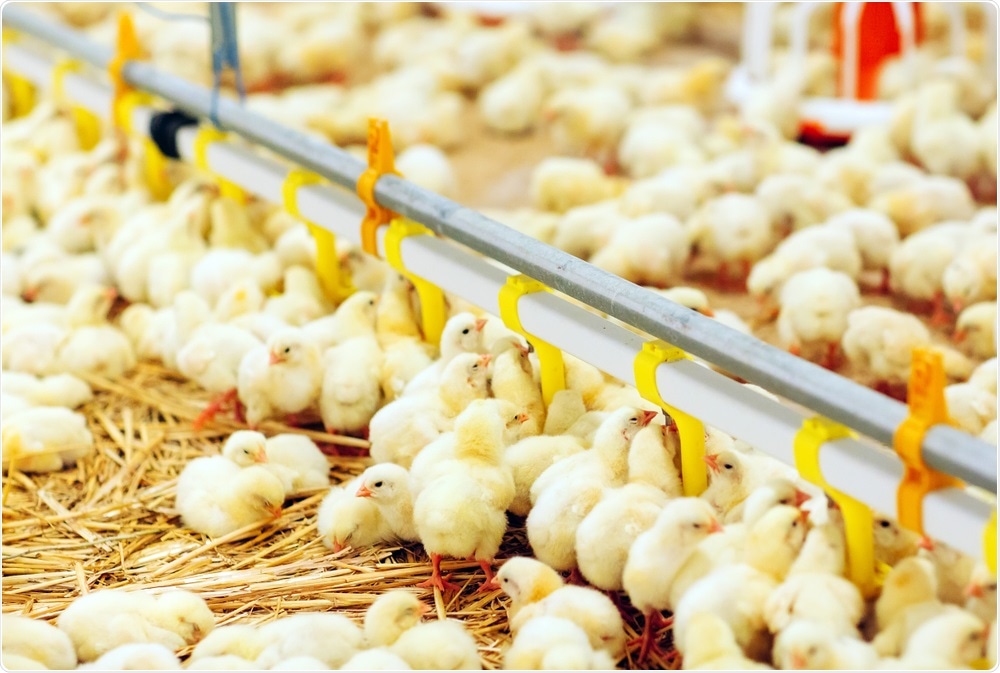As the world tries to cope with the severe acute respiratory syndrome coronavirus 2 (SARS-CoV-2) that causes coronavirus disease (COVID-19), Dr. Michael Herschel Greger has claimed that worse could be yet to come. The American nutrition expert has claimed in his latest book that the next pandemic could be due to virus emanating from poultry farms.

Indoor poultry farm. Image Credit: David Tadevosian / Shutterstock
The book
"How To Survive A Pandemic" by Dr Greger has prophesized that unless changes are made deadly viruses could come from overcrowded poultry farms where chickens are kept close in contact with each other. He has called for several measures that could be adopted to prevent viral pandemics of the future, and one of these is the modification of the current methods of poultry farming.
In his previous book "How Not To Die" he postulated similar ideas and warnings regarding the spread of bird flu. Dr Greger has claimed that COVID-19 could be considered a category two or three in the 'hurricane scale' of pandemics and that a more deadly pandemic, perhaps "100 times worse when it comes" could produce a "fatality rate of one in two".
The COVID-19 pandemic has been detected in over 6.26 million people worldwide and killed 375,513 individuals globally, according to statistics on June 1st 2020 from the Center for Systems Science and Engineering (CSSE) at Johns Hopkins University (JHU). In recent history, this has been one of the worst pandemics to hit the world.
Why poultry farms?
According to Greger, chickens that are mass-produced for food are often kept in cramped spaces, and this could be one of the ideal breeding grounds for viral diseases such as bird flu. He said in his statement, “The more animals jammed together, the more spins the virus may get at the roulette wheel while gambling for the pandemic jackpot that may be hidden in the lining of the chickens’ lungs.”

Image Credit: David Tadevosian / Shutterstock
History of viral diseases associated with birds
According to Dr. Greger, the bird flu (H5N1) outbreak in Hong Kong in 1997 was directly acquired from the birds kept in poultry farms. Of the 18 individuals infected, he warned, six had died. This was a very high case fatality rate Greger pointed out. Since then, there have been several outbreaks between 2003 and 2009. He explained that the virus never really went away despite the culling of the chickens. In his book, Greger writes that the Hong Kong outbreak began, “with a three-year-old boy in Hong Kong, whose sore throat and tummy ache turned into a disease that curdled his blood and killed him within a week from acute respiratory and organ failure.” It had started at a bird market, he warned.
He said that there had been several bird flu outbreaks in China despite several efforts to eliminate the virus. Millions of chickens have been culled in an effort to stop the spread of the infection. He added, “The worry is that the virus never stands still but is always mutating. This is the monster lurking in the undergrowth, the one that makes epidemiologists shudder.”
The bird droppings are rich in ammonia, he said. This is basically an ideal situation where the viruses can mutate and multiply. Combined with that, the crowding helps the spread, he pointed out.
Bird flu
Bird flu or avian flu is a highly contagious viral infection that is transmitted between birds and on rare occasions, from birds to humans.
There are several varieties of bird flu, the majority of which do not affect humans. However, two types of bird flu have caused a lot of concern over recent years. These are the H5N1 virus, which was found to infect humans in 1997 and the H7N9 virus which infected humans in 2013.
Although these viruses are not usually spread between humans, they have claimed the lives of a number of people. Other strains of the bird flu virus that can infect humans include H7N7 and H9N2, although these strains do not usually cause severe illness.
The earliest reported case of the H5N1 virus affecting humans occurred alongside an H5N1 epidemic in non-humans (epizootic outbreak) in Hong Kong poultry. The entire poultry population was then culled to prevent the disease from going on to affect other animal species (panzootic outbreak).
However, the disease still spread and the World Health Organization announced in December 2009 that it had affected a total of 447 people and claimed 263 lives.
Researchers soon discovered that H5N1 is easily spread between birds meaning the virus could potentially spread across the world. Although H5N1 can mutate to form strains that are infective to species not previously thought to be affected by the virus, not all of those strains are infective to humans. The virus preferentially binds to a galactose receptor present in the avian respiratory tract. These receptors are virtually nonexistent in humans and occur only in the alveoli, deep within the lungs, meaning the virus cannot easily be transmitted through the usual routes such as coughing and sneezing.